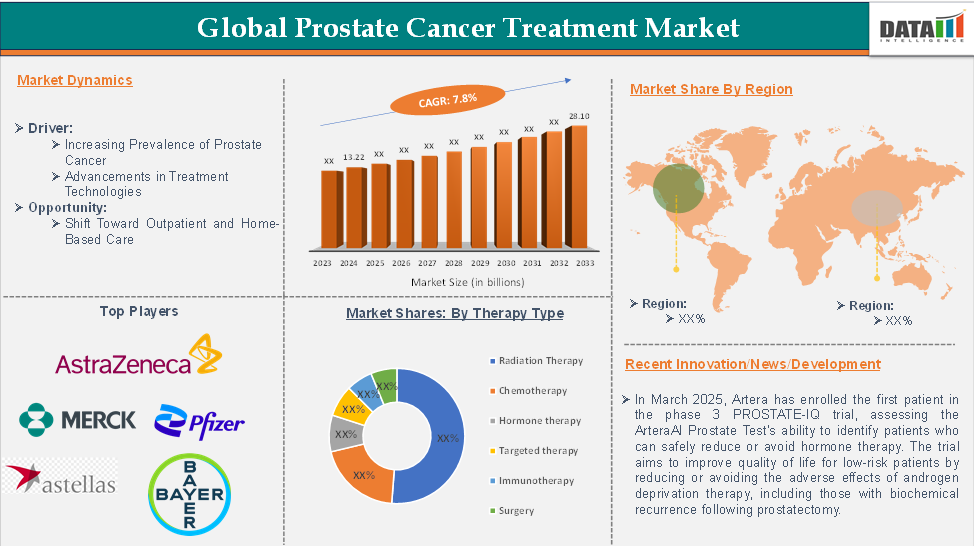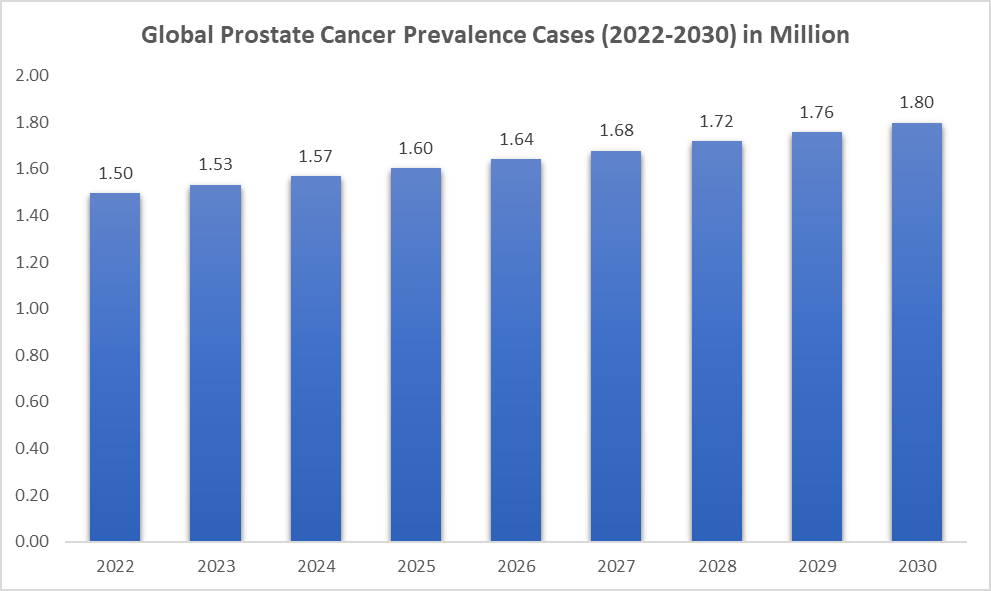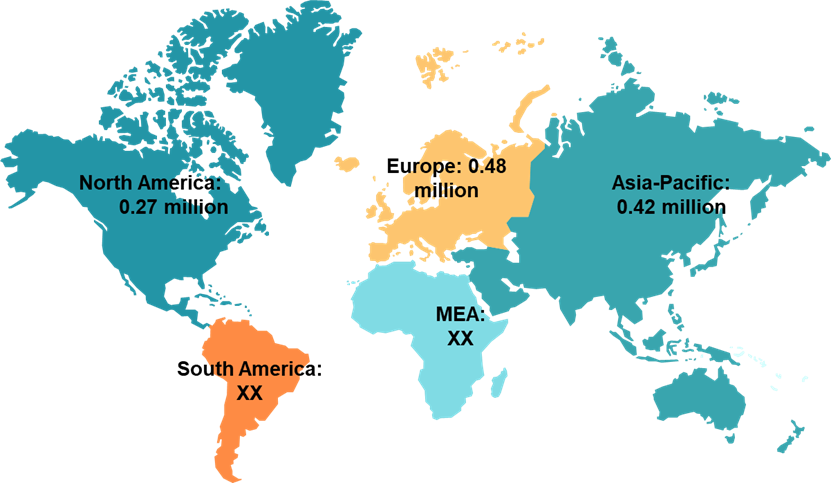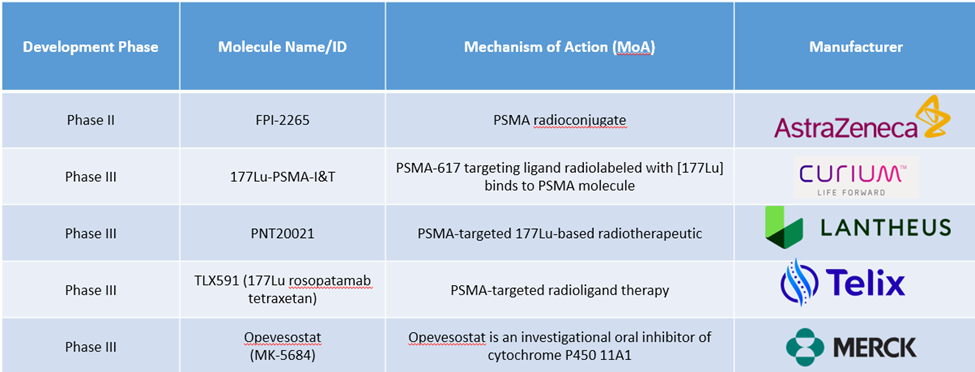Prostate Cancer Treatment Market Size
Prostate Cancer Treatment Market size reached US$ 13.22 billion in 2024 and is expected to reach US$ 28.10 billion by 2033, growing at a CAGR of 7.8% during the forecast period 2025-2033.
Prostate cancer, a common type of cancer, originates from the prostate, a small gland responsible for semen production. It is found just below the bladder and is a part of the male reproductive system. Early cases are often found early and grow slowly, with most being cured. Treatment options include surgery, radiation therapy, or monitoring the cancer's growth. If the cancer spreads beyond the prostate, there are still treatments available. However, even if a cure isn't possible, treatments can slow the cancer's growth and prolong life.
Executive Summary

For more details on this report, Request for Sample
Prostate Cancer Treatment Market Dynamics: Drivers & Restraints
Rise in the Incidence of Prostate Cancer
The global prostate cancer treatment market is growing due to its rise in the incidence among men, particularly those aged 50 and above. The growing geriatric population and advancements in diagnostic technologies have led to higher detection rates of the disease, resulting in a demand for various treatment options such as surgery, radiation therapy, hormone therapy, immunotherapy, and targeted therapies. The need for continuous management and long-term care in prostate cancer patients further supports the market expansion, prompting pharmaceutical companies to invest in novel therapeutics.
For instance, according to the Global Cancer Observatory, in 2024, 1.57 million new prostate cancer cases were reported, with a man being diagnosed every 2 minutes, and it has been raised to 1.60 million, and it is expected to rise to around 1.80 million by 2030.
High Cost of Prostate Cancer Therapies
The global prostate cancer treatment market is expanding due to its prevalence among men aged 50 and above, the geriatric population, and advancements in diagnostic technologies. This has led to increased demand for treatments like surgery, radiation therapy, hormone therapy, immunotherapy, and targeted therapies. The need for continuous management and long-term care further supports market expansion, prompting pharmaceutical companies to invest in novel therapeutics. For instance, the American Urological Association's 2023 research reveals an annual cost of $31,427 for metastatic prostate cancer, a rise attributed to the approval of new oral therapies.
Epidemiology Analysis
According to DataM estimates, prostate cancer prevalence worldwide reached 1.57 million cases in 2024, projected to rise to 1.80 million by 2030. This rise is attributed to factors like aging populations, increased awareness, lifestyle changes, and improved survival rates. The need for public health efforts, early detection programs, and advanced treatment options is highlighted, emphasizing the growing burden of prostate cancer on global healthcare systems.

Epidemiology Analysis (By Region)
The incidence of prostate cancer varies among regions. The region with the highest incidence of prostate cancer is the Europe region, accounting for 0.48 billion cases in 2024.

Pipeline Analysis
Pipeline products for prostate cancer:

Prostate Cancer Treatment Market Segment Analysis
The global prostate cancer treatment market is segmented based on stage, therapy, and region.
Therapy:
The radioligand therapy segment is expected to dominate the prostate cancer treatment market with the highest market share.
Radioligand therapy (RLT) is a therapy that uses a radioactive isotope and a ligand to target cancer cell receptors, particularly in prostate cancer. It targets the prostate-specific membrane antigen (PSMA), delivering localized radiation to the tumor, minimizing damage to healthy tissue. This therapy is particularly beneficial for patients with metastatic castration-resistant prostate cancer who have exhausted conventional treatments.
The radioligand therapy segment is expected to grow due to factors such as rising global prevalence, increased awareness, and demand for advanced therapies like targeted laser therapy (RLT). Advancements in diagnostics, strong research pipelines, regulatory approvals, and expanding access to new treatments in emerging markets support market expansion. The aging male population and lifestyle-related risk factors also contribute to the market's growth trajectory.
For instance, in March 2025, Novartis received FDA approval for Pluvicto, a drug used to delay chemotherapy in patients with PSMA-positive metastatic castration-resistant prostate cancer who have been treated with ARPI therapy and are considered appropriate for this treatment.
Prostate Cancer Treatment Market Geographical Share
North America is expected to hold a significant position in the global prostate cancer treatment market, with the highest market share
North America dominates the global prostate cancer treatment market due to its high prevalence, robust healthcare infrastructure, advanced diagnostic capabilities, and early adoption of innovative therapies. Government and private health insurance programs provide access to costly treatments, while intensive research and development activities, leading pharmaceutical companies, and favorable regulatory frameworks like FDA fast-track approvals support rapid innovation and commercialization of new prostate cancer therapies. This market growth is fueled by a growing patient pool, robust healthcare infrastructure, and favorable regulatory frameworks.
For instance, in March 2025, The U.S. Food and Drug Administration approved 177Lu-PSMA-617 (Pluvicto) for prostate cancer treatment, allowing earlier use of the therapy. This treatment targets PSMA, a protein on cancer cell surfaces, delivering radiation that damages DNA and destroys cancer cells. The therapy is now more accessible to more patients.
Prostate Cancer Treatment Market Top Companies
Top companies in the prostate cancer treatment market include Astellas Pharma, AstraZeneca, Bayer AG, Dendreon Pharmaceuticals, Exelixis Inc, Ferring B.V, Johnson & Johnson (via Janssen Pharmaceuticals), Pfizer Inc, Sumitomo Pharma Co., Ltd, Novartis and Tolmar, Inc among others.
Key Developments
In February 2025, Israeli pharmaceutical company RedHill Biopharma is conducting a Phase II trial to evaluate the combination of opaganib and darolutamide in treating metastatic castrate-resistant prostate cancer (mCRPC). The study, involving 80 male subjects, uses a lipid biomarker test, PCPro, to identify patients with poor prognosis who may benefit from the combination.
Market Scope
Metrics | Details | |
CAGR | 7.8% | |
Market Size Available for Years | 2022-2033 | |
Estimation Forecast Period | 2025-2033 | |
Revenue Units | Value (US$ Bn) | |
Segments Covered | Stage | Stage I, Stage II, Stage III, Stage IV |
Therapy Type | Radioligand Therapy, Radiation Therapy, Chemotherapy, Hormone therapy, Targeted therapy, Immunotherapy, Surgery, | |
Regions Covered | North America, Europe, Asia-Pacific, South America, and the Middle East & Africa | |
Why Purchase the Report?
Pipeline & Innovations: Reviews ongoing clinical trials, product pipelines, and forecasts upcoming advancements in medical devices and pharmaceuticals.
Product Performance & Market Positioning: Analyze product performance, market positioning, and growth potential to optimize strategies.
Real-World Evidence: Integrates patient feedback and data into product development for improved outcomes.
Physician Preferences & Health System Impact: Examines healthcare provider behaviors and the impact of health system mergers on adoption strategies.
Market Updates & Industry Changes: Covers recent regulatory changes, new policies, and emerging technologies.
Competitive Strategies: Analyzes competitor strategies, market share, and emerging players.
Pricing & Market Access: Reviews pricing models, reimbursement trends, and market access strategies.
Market Entry & Expansion: Identifies optimal strategies for entering new markets and partnerships.
Regional Growth & Investment: Highlights high-growth regions and investment opportunities.
Supply Chain Optimization: Assesses supply chain risks and distribution strategies for efficient product delivery.
Sustainability & Regulatory Impact: Focuses on eco-friendly practices and evolving regulations in healthcare.
Post-market Surveillance: Uses post-market data to enhance product safety and access.
Pharmacoeconomics & Value-Based Pricing: Analyzes the shift to value-based pricing and data-driven decision-making in R&D.
The global prostate cancer treatment market report delivers a detailed analysis with 54 key tables, more than 45 visually impactful figures, and 198 pages of expert insights, providing a complete view of the market landscape.
Target Audience 2024
Manufacturers: Pharmaceutical, Medical Device, Biotech Companies, Contract Manufacturers, Distributors, Hospitals.
Regulatory & Policy: Compliance Officers, Government, Health Economists, Market Access Specialists.
Technology & Innovation: AI/Robotics Providers, R&D Professionals, Clinical Trial Managers, Pharmacovigilance Experts.
Investors: Healthcare Investors, Venture Fund Investors, Pharma Marketing & Sales.
Consulting & Advisory: Healthcare Consultants, Industry Associations, Analysts.
Supply Chain: Distribution and Supply Chain Managers.
Consumers & Advocacy: Patients, Advocacy Groups, Insurance Companies.
Academic & Research: Academic Institutions.